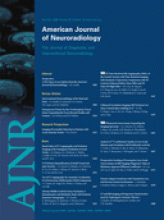A focal neurologic deficit consists of a set of symptoms or signs in which causation can be localized to an anatomic site in the central nervous system. The site of the pathologic abnormality is typically deduced through the history and physical examination before imaging. The clinical localization of a suspected lesion is extremely useful in that it assists the radiologist in directing the imaging portion of the evaluation. Focal neurologic deficits may develop suddenly or may evolve slowly. Once a deficit occurs, it may remain stable, may continue to worsen in a continuous or steplike fashion, or may resolve. Resolution may be partial or complete.
Additionally, deficits may be unifocal, implying a single lesion, or multifocal, suggesting multiple discrete lesions. A patient presenting with a focal neurologic deficit should be considered for imaging of the entire neuraxis whenever appropriate. The presentation may suggest causation. For example, an acute temporal course prompts evaluation for cerebral infarction, but a more chronically progressive course is often due to a mass lesion. Specific disease entities are fully reviewed in separate ACR Appropriateness Criteria topics. The patient who presents with a focal disorder of motor or sensory function caused by intracranial pathology is addressed in this summary.
Acute Focal Neurologic Deficit
The sudden development of a focal neurologic deficit suggests a vascular ischemic event such as an infarction. Infarctions may remain clinically stable in the immediate period of presentation or may worsen due to evolving ischemia or complicating hemorrhage or edema. A deficit from a transient ischemic attack resolves within 24 hours. Neurologic deficits from acute reversible ischemia may take up to 30 days to completely resolve. CT scanning is often used to screen patients for suspected infarction and may reveal an obscured insular ribbon or attenuated middle cerebral artery sign, but may miss early cytotoxic edema. Diffusion-weighted MR imaging detects cytotoxic edema in the first few hours of an infarction and may remain positive for a week to 10 days. Spin-echo sequences before and after intravenous enhancement may add significant information as the infarction evolves.
An intracerebral or subarachnoid hemorrhage may also cause sudden onset of focal findings. CT is generally the preferred technique for initial screening for intracranial hemorrhage because of its availability, rapid scanning time, and sensitivity in detecting blood.1,2 Recently, MR imaging has been found to be sensitive for both acute and chronic blood products and, when available, can exclude hemorrhage in patients with a suspected infarction before intravenous administration of tissue plasminogen activator.3 Moreover, MR imaging has been shown to be superior to CT in detecting acute petechial hemorrhagic transformation in acute ischemic stroke. Kidwell et al4 showed that with appropriate sequence selection, acquisition time of an MR imaging can be significantly decreased to about 10 to 15 minutes. CT is the technique of choice for screening patients for suspected subdural and epidural hemorrhage.
Chronic Progressive Focal Neurologic Deficit
Chronically worsening focal neurologic deficits may be caused by an expanding intracranial lesion such as a primary or metastatic neoplasm. Subacute or more rapidly developing symptoms may be caused by an infectious lesion. CT is invaluable for detecting intracranial tumors, infections, and vascular lesions. A retrospective review by Brown et al5 found that 20% of elderly patients (>70 years of age) presenting with neurologic deficits had treatable lesions discovered with CT. The cohort most affected by the CT imaging was the group with neurologic signs that were atypical of stroke and with unexplained confusion or altered sensorium. Contrast agents yield additional information on CT. Current-generation scanners have significantly improved sensitivity; however, some pathology such as white-matter disease and lesions causing little mass effect, may be difficult to detect. Also, CT may not reliably delineate leptomeningeal or dural disease. Moreover, it is unlikely to be of any benefit in atraumatic patients with neurologic deficits that have completely resolved at the time of imaging.
Enhanced MR imaging is more sensitive than CT for detecting primary and secondary brain lesions and for defining the extent of disease. Intravenous gadolinium contrast increases the detection of intracranial metastatic disease, especially lesions occult on unenhanced studies. Notably, meningiomas may be difficult to detect on unenhanced scans, especially if tumors are small and cause no edema. Virtually all primary brain neoplasms seen on enhanced images will also be identified on unenhanced sequences and contrast agents may not be essential for screening examinations. High-dose enhanced MR imaging results in increased lesion contrast, apparent size, and border definition compared with single-dose examinations.6
MR imaging is especially useful for evaluating the posterior fossa, a region often less well-visualized with CT because of artifact due to adjacent bony structures. MR imaging is superior for detecting of brain stem lesions and for characterizing hemorrhagic residua. Enhanced MR imaging is also the technique of choice for patients with cranial neuropathy.
While CT may be preferable for evaluating bony trauma, acute subarachnoid blood, and some head and neck disorders, MR imaging has become the technique of choice for most central nervous system disorders. Although CT is more sensitive for detecting small calcifications associated with vascular malformations, MR imaging is more sensitive for detecting the small hemorrhagic foci commonly associated with vascular malformations, and it provides a more specific imaging appearance.
Preoperative (or preradiation) functional MR imaging for mapping of eloquent cortex more precisely delineates motor and speech areas and may contribute to surgical and treatment planning.7 For treated patients with brain neoplasms presenting with new neurologic complaints, single-photon emission CT, MR spectroscopy, or positron emission tomography studies may aid in distinguishing radiation necrosis from tumor recurrence, especially when conventional imaging is ambiguous. However, these modalities are not universally reliable for making this distinction.8 Localized infection may also produce focal neurologic signs and symptoms. Although it is less sensitive than CT for detecting small calcifications, MR imaging provides greater sensitivity for assessing intracranial abscess and granulomas, and may be more specific. Contrast-enhanced images augment the sensitivity of CT and MR brain imaging in suspected infection. MR imaging is superior to CT for evaluating parenchymal abscesses, extra-axial infection and their complications. Diffusion-weighted MR imaging may differentiate brain abscess from necrotic or cystic brain tumors by demonstrating restricted diffusion in abscesses.9 MR imaging, and particularly MR venography, may also be useful for demonstrating secondary venous occlusive disease. CT is considered superior for demonstrating bone abnormalities in inflammatory ear disease and may also provide useful additional information in cases of sinusitis. CT remains the standard technique for diagnosing sinusitis, but MR imaging is often necessary to exclude intracranial complications of sinusitis such as meningitis or abscess.10 For patients infected with human immunodeficiency virus and those with acquired immunodeficiency syndrome exhibiting focal neurologic symptoms, MR imaging is superior to CT for detecting white-matter lesions and vasogenic edema, although distinguishing between lesions, such as toxoplasmosis and primary central nervous system lymphoma, is often difficult on the basis of anatomic imaging alone. Thallium-201 uptake is increased in lymphoma. MR spectroscopy may provide another noninvasive and more specific method for differentiating these lesions.11 Reduced regional cerebral blood volume (rCBV) in toxoplasmosis lesions by using perfusion MR imaging compared with increased rCBV in lymphomas may also prove useful.12
CT is the technique of choice for detecting chronic subdural hematomas that may also produce a step-wise progressive neurologic deficit due to repetitive rebleeding.
Fluctuating Focal Neurologic Deficit
Focal neurologic deficits that have a stuttering course or localize to multiple locations may be clinically challenging. One cause is demyelination, most commonly caused by multiple sclerosis (MS).13–17
MR imaging has revolutionized the diagnosis and management of MS, which previously was diagnosed solely by clinical criteria and CSF analysis. Poorly detected by CT, MS is clearly depicted by MR imaging. In a study comparing high-field MR imaging (1.5T) to low-field MR imaging (.23T), Ertl-Wagner et al18 showed that high-field studies are far superior for diagnosing MS. As promising new therapies for MS were evaluated in the early 1990s, it became clear that MR imaging was more sensitive to disease activity than the neurologic evaluation, thus allowing for smaller sample sizes and, thereby, for more economical and faster therapeutic trials.19,20
Because of its greater sensitivity for detecting edematous lesions adjacent to CSF-filled spaces, fluid-attenuated inversion recovery with fast spin-echo acquisition is quite sensitive for supratentorial MS lesions compared with conventional T2-weighted images. Enhanced MR may detect active lesions.21–25
MR spectroscopy may help clarify the pathophysiology underlying the diverse varieties of MS. Metabolic changes have been observed on MR spectroscopy before the appearance of lesions on MR imaging, but these applications have little utility in clinical practice at this time.26 MR tractography may also have a future role.
Review Information
This guideline was originally developed in 2006. The last review and update was completed in 2008.
Appendix
Expert Panel on Neurologic Imaging: Franz J. Wippold II, MD, Principal Author and Panel Chair; James A. Brunberg, MD; Rebecca S. Cornelius, MD; Patricia C. Davis, MD; Robert L. De La Paz, MD; Pr. Didier Dormont; Linda Gray, MD; John E. Jordan, MD; Suresh Kumar Mukherji, MD; David J. Seidenwurm, MD; Patrick A. Turski, MD; Robert D. Zimmerman, MD; Michael A. Sloan, MD, MS, American Academy of Neurology.
Footnotes
This article is a summary of the complete version of this topic, which is available on the ACR Website at www.acr.org/ac. Practitioners are encouraged to refer to the complete version.
Reprinted with permission of the American College of Radiology.
References
Clinical condition: focal neurologic deficit*
- Copyright © American Society of Neuroradiology







